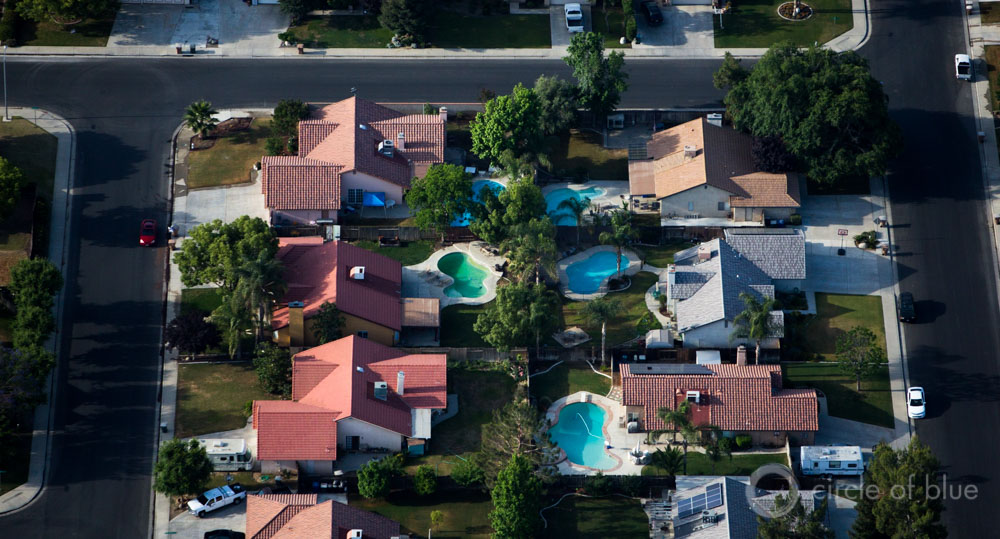California Court, Despite Drought, Questions Popular Water Pricing Tool
Increasing block rates garner closer attention.

By Brett Walton
Circle of Blue
It was not the sort of tremor that Californians prepare for with flashlights, evacuation plans, and Hollywood scripts. But a state appeals court ruling on April 20 hit the state’s water utilities with earth-shaking force.
The 4th District Court of Appeals ruled that the tiered water rates used by San Juan Capistrano, a mission town in Orange County, were illegal under California law because those residents using the most water were paying more than it cost the city for treatment and delivery. The court found that the pricing strategy violated Proposition 218, an initiative approved by voters in 1996 to limit government fees.
San Juan Capistrano, like most California cities, charges more per gallon as water use increases, just as a progressive income tax levies higher rates on big earners. Called an “increasing block rate,” the pricing tool has soared in popularity in the last two decades as utilities seek to use higher water prices to cut urban water use and avoid costly infrastructure projects to expand supply.
Two-thirds of California utilities have an increasing block rate, up from 40 percent a decade ago, according to Raftelis, a water rates consultancy. Nationally, more than half of utilities use increasing block rates. Governor Jerry Brown in April called on California utilities to use higher prices to help meet a statewide 25 percent urban water conservation goal that he ordered in response to the state’s drought emergency.
Initial fears that all increasing block rates would be banned in California because of the 4th District’s ruling are unfounded, said Sanjay Gaur, a vice president at Raftelis. Utilities can still use block rates but they need to be more diligent about matching prices with costs. “Cities can’t do as much social engineering with rates now,” Gaur told Circle of Blue, referring to setting high prices solely to deter water use.
A new legal tide, however, appears to be coming in. At least two other citizen lawsuits — in Marin County, north of San Francisco, and in Glendale, a Los Angeles suburb — have been filed against utilities that employ increasing block rates.
Even without the legal challenges, increasing block rates are under pressure — and not only in California. It’s not a backlash, not yet at least. But one by one, utilities and economists across the country are beginning to question the negative consequences, such as erratic revenues, that are borne from widespread adoption of the tiered rate.
Alternatives are readily available, but in a cautious, risk-averse industry, only a few cities — Austin, Texas, and Davis, California, for instance — have been willing to step into the unknown and institute novel rate designs. Both cities instituted a monthly fee based on the volume of water used per household, though Davis’s was rejected in a referendum. The goal of any such change is to discover the elusive balance between stable budgets, affordable water, and prices that are high enough to rein in demand.
“Alternatives to the increasing block are not common yet,” Shadi Eskaf, a water rates researcher at the University of North Carolina’s Environmental Finance Center, told Circle of Blue. “But we’re seeing more discussion and acceptance that this might be the way to go.”
Water Rates Reversal
Not so long ago, increasing block rates were a new idea.
Eskaf points to a 1971 paper as one of the first scholarly evaluations of what was, at that time, an untested concept. The common thinking four decades ago was the opposite of today’s norms. The study cites a water rates survey of 123 U.S. cities that found that some 94 percent used declining block rates, in essence a bulk discount for water. Under a declining block, the more you use, the less you pay per gallon. It is an incentive to consume.
The shift toward increasing blocks began during a drought in Tucson, Arizona, in 1974 and spread slowly but steadily through the American West as cities approached water supply limits. Existing sources were being exhausted and system expansions were politically or economically improbable. Reducing consumption had to be the goal.
Increasing blocks made intuitive sense. They matched economic theories about price and demand. They seemed just and fair. Residents who used more water paid more. Higher prices in the upper tiers would put a brake on water use. Cheap blocks of water at the low end of the consumption scale would provide poor people with water at low cost.

Increasing blocks even appeared in Seattle, which in the late 1980s experienced escalating growth in water use. If the city’s trend lines continued upward, a new water source would have been necessary in just a few years to complement the city’s two Cascade Mountain reservoir systems.
“We’re never going to get sources as good as we have now,” Bruce Flory, a Seattle Public Utilities economist, told Circle of Blue, reflecting on the utility’s thinking at the time. “We said, ‘Let’s go systematic about conservation.’”
The utility flipped its rate structure. Instead of high fixed fees, which are paid regardless of how much water is used, it increased the price per gallon. Rate increases were tacked on the highest blocks. Other non-economic tools helped. Plumbing standards were tightened, and leaky pipes were patched. Education campaigns informed citizens about the need to conserve.
The plan worked. Seattle water use dropped 30 percent, from a 1990 peak of 647 million liters (171 million gallons) per day to 458 million liters (121 million gallons) daily today. A new supply source will not be needed until 2060, according to Seattle Public Utilities.
Drawbacks to Increasing Block Rates
Similar success stories are common in the United States as personal water use declines. But teasing out how much of the conservation benefit comes from increasing block rates is difficult, according to economists. In fact, increasing blocks might have little effect at all.
A 2007 study from economists Sheila Olmstead and Robert Stavins found that price increases, and not the tiered pricing, were responsible for the drop in water use.
“Increasing blocks started as a good idea to charge based on burden,” David Zetland, an economist at Leiden University College, in Amsterdam, told Circle of Blue. “They became an acceptable idea, but there is no good reason to do an increasing block, in terms of the academic literature.”
Both Zetland, who studied water management agencies in California for his doctoral thesis, and Eskaf agree that the argument to help low-income consumers — that low-cost blocks provide less affluent residents cheap water — might also be only partly true. Utilities, for example, often do not have data on the number of people per household. If there are more people sharing a home, the combined consumption, even if small individually, might push household use into the more expensive tiers.
“Increasing blocks are pro low-water user,” Zetland said. “Not necessarily pro-poor.”
In practice, increasing block rates introduce a new set of problems for utilities, namely for the budget.
Austin, Texas, like so many of its peers, has an increasing block rate. The cost of providing water to users in the lowest tier is subsidized by revenue from the frequent lawn-waterers who occupy the highest tiers. But when water use dips — as it does during exceptionally dry or wet years — so does revenue.
Central Texas, in 2010, was such a place. It was a wet year and Austinites did not turn on the sprinklers nearly often enough for the utility to meet its budget. The balance sheet ran red with a $US 53 million shortfall.
“By having the increasing block rates set up as they are,” Eskaf explained, “revenue generation depends quite a lot on the highest tiers. Utilities find that revenue is becoming increasingly variable, and that’s becoming a problem.”
New Ideas Slow to Catch On
Water utilities are not big risk takers. They prefer to do what has already been proven. Zetland called the business “a very serious followership culture.” Eskaf said that increasing block rates have become so common partly because of a “safety in numbers” herd mentality among utilities.

Even so, a few utilities are trying new models. Of the country’s largest utilities, Austin Water has been the most willing to tinker, experiment, and implement new rate designs. After its experience in 2010, it had to be.
In 2012, Austin Water instituted what is known as a consumption-based fixed rate. Usually fixed charges are based on the size of a household’s water meter. But meter size is a poor indicator of the strain a household places on a city’s water supply. It’s the amount of water that is costly, not the diameter of the pipe that delivers it to the home. More appropriate, according to advocates of the consumption-based rate, is a fixed fee that corresponds to peak water use, typically the summer months, when lawns are watered.
Austin’s changes have stabilized the budget. It gets a higher share of revenue from fixed fees, and it relies less on high-volume customers. Whereas three years ago roughly 10 percent of customers saw their water use hit the highest tier, only 4 percent now use that much, according to David Anders, assistant director of finance. That means that prices in the lower tiers have increased to cover the lost subsidy, but overall the utility’s finances have improved even as water use drops. Austin used 37.8 billion liters (10 billion gallons) less water in 2014 than in 2011, a 20 percent drop.
“The rate structure changes have put us in a better position financially,” David Anders told Circle of Blue.
Other cities tried this model and failed. Davis, California, for instance, put a consumption-based charge in place in 2013 only to see it voted down the following year in a public referendum.
Still other ideas exist. Zetland, who used to be a proponent of increasing blocks, now argues for a different model. Under his plan, utilities would set a uniform volumetric price, in which each unit of water costs the same, thus recycling a rate structure that was popular decades ago. Utilities would also charge a fixed fee that includes the cost of infrastructure maintenance and the cost of acquiring new supplies, in part to avoid doing so by reducing water use. Any surplus revenues would be returned to customers as a rebate.
Seattle, for its part, is not ready to ditch its rate structure, which uses block rates in the summer, when demand is highest. But managers are putting the rates under the microscope.
“We’re doing a thorough reassessment now of our rate structure,” Flory said. “We want something sustainable. We don’t want to change it every three years. Looking back, block rates were successful. But we want to find out what is the right structure moving forward.”
Reassessments in California
Increasing block rates are not dead, but they are evolving. Many cities in California, because of the Proposition 218 ruling, will take a second look at how they calculate their rates.
As its lawsuit moved through the courts, San Juan Capistrano was rebuilding its rate structure. The city still has an increasing block rate, but the cost of water in the highest tier has been cut by more than half, from $US 11.67 per 2,831 liters (748 gallons) to $US 5.15.
According to Sanjay Gaur of Raftelis, to make an increasing block rate viable under Proposition 218 a utility must justify the price.
“They have to show that there is a logic to the higher tiers,” said Gaur, who helped San Juan Capistrano revise its rates.
Now that California utilities have settled from the initial shock of the 4th District’s ruling, many are finding their footing again, looking for ways, like all utilities, to balance conservation, revenue, and social equity – but with a closer eye on matching costs and prices.
Brett writes about agriculture, energy, infrastructure, and the politics and economics of water in the United States. He also writes the Federal Water Tap, Circle of Blue’s weekly digest of U.S. government water news. He is the winner of two Society of Environmental Journalists reporting awards, one of the top honors in American environmental journalism: first place for explanatory reporting for a series on septic system pollution in the United States(2016) and third place for beat reporting in a small market (2014). He received the Sierra Club’s Distinguished Service Award in 2018. Brett lives in Seattle, where he hikes the mountains and bakes pies. Contact Brett Walton
Leave a Reply
Want to join the discussion?Feel free to contribute!










Nice article (besides quoting me :). I’ll add/clarify that my recommendation is to raise the variable price above cost of delivery when water is scarce (same as summer surcharges) to prevent a shortage (is a shortage a cost to consider?) and rebate THAT money back, per meter. That’s where the rebate comes from, to make sure customers get their money back while using price (not command and control) to keep demand within supply.
Here’s one of the water purveyor roles listed in my Regional Scarcity paper: “Budget-based and/or increasing water rate structure with a rate relief program for qualified low-income households. Water rates may contain added regional watershed scarcity value of water. Higher water rates are charged to new extended service area connections in outward growth developments. Full cost recovery and a regional scarcity value applied to beverage bottling companies exporting public water supply.”
Basically, it seems like someone did a poor job researching or justifying the economic and cost basis for the rate structure. Of course, legislative and regulatory clarity would help too. The short-run marginal cost of water can be very low, giving the appearance (even to some economists) that prices should be undifferentiated or even “fixed” or “flat.” However, rate design can be revenue neutral and take long-run marginal (more pragmatically, incremental) costs into account as the basis for seasonal and/or tiered rates. Rate levels and (relatively simple) tiers can be used to refine price signals and promote efficiency, especially with regard to more discretionary outdoor use, but also to satisfy equity goals of ratemaking (aligning costs with causation and promoting affordability, albeit without consideration of non-cost criteria, such as household size). But utilities need to provide a cost study to back it up and public engagement on ratemaking goals. Even though water is a high fixed-cost industry, and utilities must be financially viable, we need to resist the idea of “decoupling” rates and bills from water usage, which would forego efficiencies that could avoid operating costs in the short run and capital costs in the long run (in the long run all costs are variable). These problems are perpetuated by outdoor usage and its role in the industry’s capacity utilization profile and revenue model. There is some dissonance in calling for more dynamic (“smart”) energy pricing to smooth load curves while calling for more flat water pricing. As always, more empirical work and dialog are needed.
If their are tiered rates now based on the true cost of providing water service. How can a city (like Sacramento,CA) get away with selling water at a loss as they do to water bottling companies like Nestles and other bottlers for less than a Penney a gallon?
Good question. The cost-of-service study should justify the cost allocation and rate structure by customer class. Large-volume customers pay lower rates overall because the cost to serve them is lower (based on the load profile). In this case, rate tiers may not be justified. However, it is probably time to revisit our clunky customer classification system and use meter data to refine the categories based on peaking factors and other cost-based criteria.